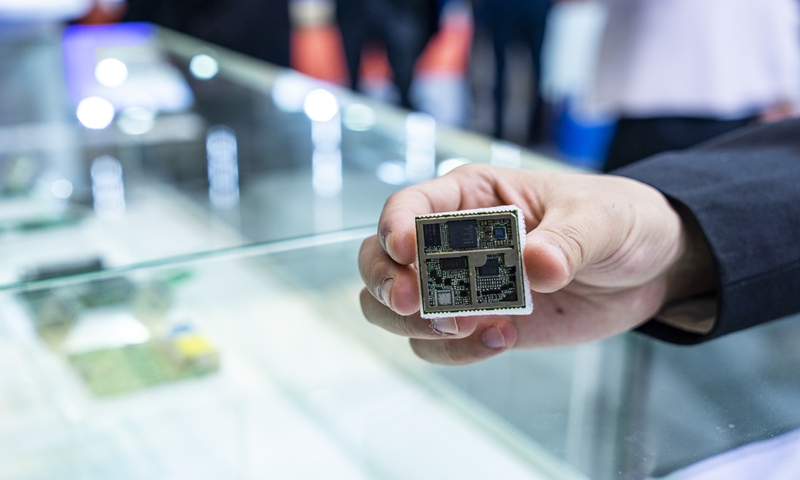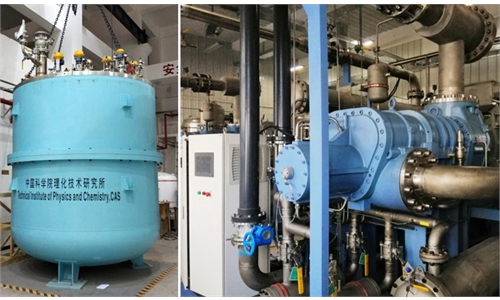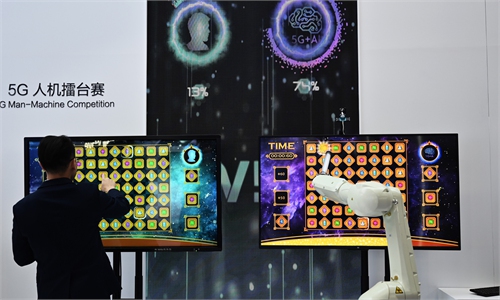China’s SOEs to lead tech self-reliance push amid US crackdown
State-owned firms to focus on ‘bottleneck’ technologies amid US crackdown

An employee showcases a semiconductor integrated circuit at an industry expo. Photo: VCG
A bureau under China's state-owned assets supervisor on Sunday released a recommendation list of 178 technology innovations of centrally administrated state-owned enterprises (SOEs), highlighting breakthroughs in such sectors as semiconductors, server operating systems, core electronic components, key materials and advanced manufacturing.Most of the items are vulnerable "bottleneck" industries at the forefront of a full-blown technology battle between the world's two largest economies, and they embody part of China's ongoing efforts to achieve technology independence, where these SOEs are expected to play a bigger role going forward.
SOEs could explore areas that private companies have avoided, while playing a leading and bridging role in integrating the resources of research institutes, private firms and capital, to obtain maximum results in cutting-edge technology breakthroughs amid the US' relentless crackdown, analysts said.
Innovations in the list include the DSP HunXin-1 chip - a high-performance IC chip developed by China Electronics Technology Group Corp, a 5G millimeter-wave communication ratio frequency chip developed by China Aerospace Science and Industry Corp, the Jiutian artificial intelligence platform developed by China Mobile, and the Kylin operating system developed by China Electronics Corp, according to a statement on the website of the State-owned Assets Supervision and Administration Commission (SASAC) on Sunday.
Other projects involve hydrogen storage material and solid hydrogen storage technology, hydrogen-based fuel-cell engines, and 12-inch, ultra-high copper material for large-scale semiconductors.
The list was released as the country opened the 5th National Science and Technology Workers Day on Sunday.
"This is an important measure from the SASAC to show [the determination] to strengthen tech self-reliance… and a practice to maintain the security and stability of [China's] supply chain," the statement said.
Going forward, the SASAC will strive to better play its strategic supporting role in building domestic technology. It will set up relevant work mechanisms to promote tech innovation application, facilitate the application of those results in centrally administrated SOEs and industry chains, and continue to improve tech products' market competitiveness and reliability, according to the statement.
On Friday, Chinese President Xi Jinping also called for accelerated efforts in building China into a leader in science and technology, and achieving science and technology self-reliance and self-strengthening at higher levels, the Xinhua News Agency reported.
He made the remarks while addressing a meeting of the general assemblies of the members of the Chinese Academy of Sciences and the Chinese Academy of Engineering, and the national congress of the China Association for Science and Technology.
"Amid the US' increasing tech pressure and bullying, the clock for China to develop its own technologies is ticking, and this is why China's top leadership and central government have been sending such signals in tense steps," Wang Peng, assistant professor of the Gaoling School of Artificial Intelligence at Renmin University of China, told the Global Times on Sunday.
Analysts said that the new list reflects the urgency of Beijing's tech development blueprint on two fronts. One is to cement leading advantages in high-tech sectors such as new energy, new materials, advanced equipment and batteries. The other is to encourage domestic players to "head to the hills," shaking up the bottlenecks that are constrained by the US.
"The government aims to make centrally administrated SOEs play a leading and demonstrative role in achieving core technology breakthroughs, because these companies' ultimate aim is to stabilize the foundation of the Chinese economy rather than making profit," Wang said.
"SOEs have a responsibility in tackling hard-to-crack technology problems, especially in sectors that private companies wouldn't enter due to technology barriers or profitability concerns," Wang said, pointing to the semiconductor industry, which requires long-term, risky investment.
There is also the issue of bringing new technology to the market, and analysts believe that SOEs could serve as a bridge to channel funds, basic infrastructure and application scenarios for both sides.
"Centrally administrated SOEs have rich resources, top talent, and sufficient capital. At break-glass moments, they need to stand out to organize all kinds of market elements to improve the efficiency of tech R&D," Ma Jihua, a veteran industry analyst, told the Global Times on Sunday.
As part of the national push for technology independence, China is also doubling down on efforts to develop local technology talent over the next decade. Last week, China tapped 12 top universities, including Peking University and Tsinghua University, to build "schools of future technology."




